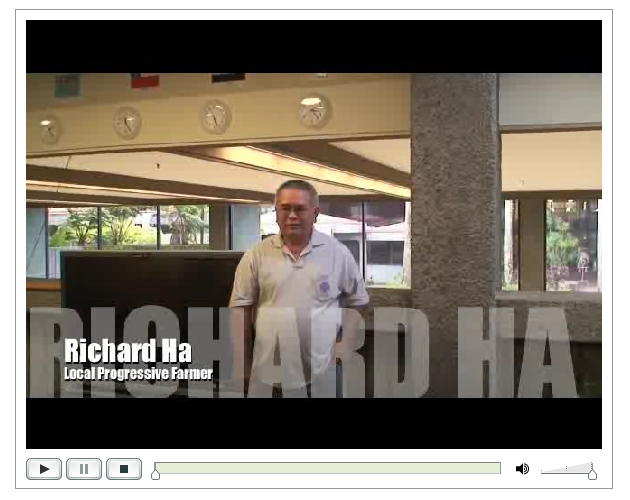Richard Ha writes:
Several years ago, the owner of a large, organic produce distributor visited us from Tokyo to explore whether we could supply bananas to Japan. He was soft-spoken and reserved. We had dinner with him and his interpreter, and he was so formal that I felt a little uncomfortable wearing my shorts at dinner. We arranged to show him our banana farming operation the following day.
As we showed him the banana packing operation, we explained about our sustainable farming methods as well as our food safety procedures, but we couldn’t tell whether we made a favorable impression or not.
Then we demonstrated how we harvest bananas. We stood at the road alongside our rows of bananas and watched as our harvester Albert notched the banana tree so it would bend over just right, placing most of the banana bunch weight on his shoulder. Then he cut the bunch off and carried it to the trailer. Up to that point, it was a routine demonstration.
But then Albert went back to cut the tree down and move its pieces so they’d be out of the way of the fertilizer tractor.
Our banana trees are very healthy and their trunks are as thick as a man’s torso. The standard tool used to harvest bananas is a razor-sharp machete with a two-foot blade.
Albert swung his machete once and cut the tree completely off, and then on the back swing he chopped it in two more pieces before it hit the ground.
Unexpectedly, our quiet, reserved guest yelled, raised his arms and leapt completely off the ground. Glancing at him, I instantly guessed what he saw–a samurai warrior swinging his sword cleanly through the enemy.
That’s what banana harvesters are like: Samurai warriors.
Only certain people can be banana harvesters. It’s not necessarily the biggest, strongest or baddest person who will become a successful banana harvester. It’s the person who has the most determination and mental toughness. I’ve seen lots of big, strong and mean guys over the years who just could not handle the job. A successful banana harvester doesn’t give up just because the job is hard. He has much more pride than that.
Watch our Harvest Superviser Radley Victorino harvest a bunch of bananas in this video (above), and notice how he positions the bunch on his shoulder. When he swings and cuts the bunch off the tree, he doesn’t flinch at the weight of that bunch dropping onto him—though that bunch probably weighs more than a hundred pounds.
Banana harvesting is by far the most physically demanding job on the farm. Good harvesters, like Radley, make it look easy. It’s not easy at all.
To help, we’ve invented a system where our banana harvesters walk only an average of seven steps with a bunch on his back. In Central America, it’s common for banana harvesters to carry the heavy bunches 100 feet or more. We’ve also designed our trailers so the harvesters don’t have to bend forward too much to put the bunch down. And we use a winch system to lift the bunches off the trailer.
The deal with the Japanese importer didn’t come to fruition, but it gave me a great new way of thinking about our harvesters–as Samurai.
No matter how you cut it, so to speak, you have to be tough to be a banana harvester. I’m proud to have been the original banana harvester more than 25 years ago. That’s how come I know what a difficult job it is, and it’s why I have such enormous respect for our banana harvesters.

